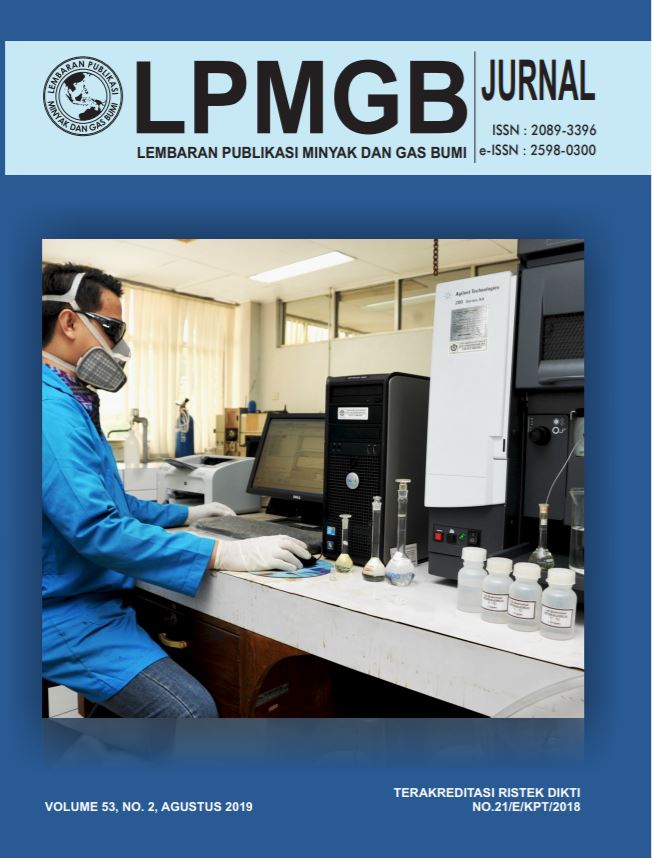PENGUKURAN KINERJA INHIBITOR KOROSI MENGGUNAKAN METODE ELEKTROKIMIA
DOI:
https://doi.org/10.29017/LPMGB.53.2.356Kata Kunci:
Korosi dan oksidasi, logam dan paduan, inhibitor korosi, penyerapan isotermal langmuir.Abstrak
Tujuan dari penelitian ini adalah untuk mengetahui kinerja dari dua jenis inhibitor, yaitu inhibitor A (Glycol base) dan inihibitor B (Amine base) yang digunakan untuk menurunkan reaksi korosi dalam media larutan air garam (brine water) yang dijenuhkan dengan CO2. Kinerja dari kedua jenis inhibitor ini diukur menggunakan metode elektrokimia, pemindaian mikroskop elektron (SEM) dan difraksi sinar X. Efi siensi inhibitor dihitung dari kepadatan arus korosi, ketahanan arus (Icorr), dan polarisasi (Rp). Hasil dari metode elektrokimia menunjukkan bahwa efi siensi inhibitor meningkat dengan meningkatnya konsentrasi. Kedua inhibitor bertindak sebagai inhibitor yang baikn pada konsentrasi 250 ppm dengan efesiensi optimum sebesar 89 % (inhibitor A) dan 96 % (inhibitor B). Hasil dari Scanning Electron Microscopy (SEM) terhadap permukaan baja karbon menunjukkan transformasi morfologi baja karbon menjadi lebih baik setelah penambahan inhibitor. Perilaku adsorpsi inhibitor pada permukaan baja adalah bersifat kimia dan mematuhi hukum penyerapan isotermal Langmuir.
Referensi
Abduh, M., 2008. The 5The 50 major engineering failures in oil and gas and hydrocarbon industry (1977-2007). [Online] Available at: https://www. scribd.com/document/215642171/The-50-Major- Engineering-Failures
Azhar, M.E., Trasniel, M., Mernari, B., Gengembre, L., Bentiss, F., & Langrenee, M., 2002. Electrochemical and XPS studies of 2,5-bis(npyridyl)- 1,3,4-thiadiazoles adsorption on mild steel in perchloric acid solution. Applied Surface Science, 15 January, 185(3-4), pp. 197 205.
ASTM G5-94, 2004. Standard Reference Test Method for Making Potentiostatic and Potentiodynamic Anodic Polarization Measurement. In: ASTM G5- 94. s.l.:American Society for Testing and Materials.
ASTM, 2004. Standard Test Method for Conducting Potentiodynamic Polarization Resistance Measurements. In: ASTM G59. s.l.:ASTM International (ASTM).
Barker, R., Hu, X. & Neville, A., 2013. The infl uence of high shear and sand impingement on preferential weld corrosion of carbon steel pipework in CO2 -saturated environments. Tribology International, December, Volume 68, pp. 17-25.
Bentiss, F., Lebrini, M., Langrenee, M., Traisnel, M., Elfarouk, A., & Vezin, H., 2007. The Infl uence of Some New 2, 5-disubstituted 1, 3, 4-thiadiazoles on the Corrosion Behaviour of Mild Steel in 1 M HCl Solution: AC Impedance study and theoretical Approach. Electrochimica Acta, 1 August, 52(24), pp. 6865-6872.
Burkle, D., De Motte, R., Taleb, W., Kleppe, A., Comyn, T., Vargas, S.M., Neville, A., & Barker, R., 2016. Development of an electrochemically integrated SR-GIXRD fl ow cell to study FeCO3 formation kinetics. Review of Scientifi c Instruments, October.Volume 87.
Davis, J. R., 2011. The Effects and Economic Impact of Corrosion. Corrosion Understanding the Basics. s.l.:ASM International.
Ibrahimi, B.E., Jmiai, A., Bazzi, L. & El Issami, S., 2020. Amino acids and their derivatives as corrosion inhibitors for metals and alloys. Arabian Journal of Chemistry, January, 13(1), pp. 740-771.
Hosseini, M., Ehteshamzadeh, M. & Shahrabi, T., 2007. Protection of mild steel corrosion with Schiff bases in 0.5 M H2SO4 solution. Electrochimica Acta, 1 March, 52(11), pp. 3680-3685.
Hua, Y., Barker, R., Charpentier, M.W., & Neville, A., 2015. Relating iron carbonate morphology to corrosion characteristics for water-saturated supercritical CO2 systems. The Journal of Supercritical Fluids, March, Volume 98, pp. 183-193.
Hua, Y., Mohammed, S., Barker, R. & Neville, A., 2020. Comparisons of corrosion behaviour for X65 and low Cr steels in high pressure CO2-saturated brine. Journal of Materials Science & Technology, 15 March, Volume 41, pp. 21-32.
Hutchings, I. & Shipway, P., 2017. Tribology: Friction and Wear of Engineering Materials. 2nd ed. s.l.:Butterworth-Heinemann.
Ige, O., Barker, R., Hu, X., Umoru, L.E., & Neville, A., 2013. Assessing the in fl uence of shear stress and particle impingement on inhibitor effi ciency through the application of in-situ electrochemistry in a CO2 -saturated environment. Wear, 15 July, 304(1-2), pp. 49-59.
Javaherdashti, R., Nwaoha, C. & Tan, H., 2013. Corrosion and Materials in Oil and Gas Industries. 1st ed. s.l.:CRC Press..
Jiang, J., Xie, Y., Islam, M. A. & Stack , M. M., 2017. The Effect of Dissolved Oxygen in Slurry on ErosionCorrosion of En30B Steel.. Journal of Bio- and Tribo-Corrosion, 3(45).
Lahiri, A. K., 2017. Applied Metallurgy and Corrosion Control. s.l.:Springer, Singapore.
Nofrizal, N., Impey, S., & Michael, R., 2017. Preferential Weld Corrosion in CO2 Environment. France, s.n.
Nofrizal, N., Rahim, A.A., Saad, B., Raja, P., Syah, A.M., & Yahya, S., 2012. Elucidation of the Corrosion Inhibition of Mild Steel in 1.0 M HCl by Catechin Monomers from Commercial Green Tea Extracts.. Metallurgical and Materials Transactions A, Volume 43, p. 13821393.
Nugroho, F., 2015. Penggunaan Inhibitor Untuk Meningkatkan Ketahanan Korosi Pada Baja
Karbon Rendah. Jurnal Angkasa, Mei.VII(1).
Owen, J., Ramsey, C., Barker, R. & Neville, A., 2018. Erosion-Corrosion of X65 Carbon Steel in Aqueous CO2 environments. Wear, 15 November , Volume 414-415, pp. 376-389.
Pidcock, A., 2014. Control of Magnesium Alloy Corrosion through the Use of Engineered
Intermetallics. s.l.:School Of Applied Sciences.
Rahim, A. A., 2005. Physico-Chemical Characterisation of Mangrove Tannins as Corrosion Inhibitors. s.l.:University Sains Malaysia.
Revie, R. W. & Uhlig, H. H., 2008. Corrosion and Corrosion Control; an Introduction to Corrosion Science and Engineering. 4th ed. s.l.:Wiley.
Sabirneeza, A. A. F. & Subhashini, S., 2014. Corrosion inhibition, adsorption and thermodynamic properties of poly(vinyl alcohol-cysteine) in molar HCl. Arabian Journal of Chemistry, February.51(2).
Sanni, O. S., Bukuaghangin, O., Charpentier, T. V. & Neville, A., 2019. Evaluation of laboratory techniques for assessing scale inhibition effi ciency.. Journal of Petroleum Science and Engineering, November.Volume 182.
Sorkhabi, H. & Asghari, E., 2008. Effect of hydrodynamic conditions on the inhibition
performance of l-methionine as a green inhibitor. Electrochimica Acta, 30 December, 54(2), pp. 162-167.
Stuart, B. H., 2013. Infrared Spektroscopy Fundamntal & Application. s.l.:Wiley.
Tanupabrungsun, T., Brown, B. & Nesic , S., 2015. Corrosion of mild steel in an aqueous CO2 environment - basic electrochemical mechanisms revisited. Corrosion Confrence and Expo, pp. 1-11.
Tsoeunyane, M. G., Makhatha, M. E. & Arotiba, O. A., 2019. Corrosion Inhibition of Mild Steel by Poly(butylene succinate)-L-histidine Extended with 1,6-diisocynatohexane Polymer Composite in 1 M HCl. International Journal of Corrosion.











